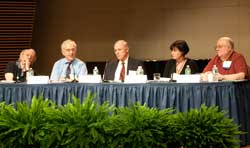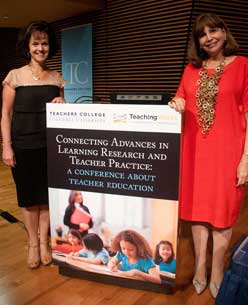Filed Under > Research/Publications
Connecting Teaching to Research
A major conference at TC lays out a vision for equipping new teachers to use the growing body of scientific knowledge about how people learn.
By Siddhartha Mitter and Joe Levine
The slide on the screen in TC’s Cowin Conference Center showed a medical student administering defibrillator pads to a mannequin. An attending physician stood next to her, guiding her hands as she pressed the pads to the dummy’s chest. A small knot of fellow students looked on.
The picture has “implications for the ‘what’ of curriculum – for what there is for people to learn as they learn to teach, what people need to know,” said the speaker, Deborah Loewenberg Ball, Dean of the School of Education at the University of Michigan. “But also, along with the ‘what’ is the ‘how does one teach practice?’ question.” The attending in the slide is showing the student how hard to hold the probes, Ball said, but they’re also discussing the relationship between pressure and the patient’s size. “The conversation bridges knowledge and practice.”
So, too, did “Connecting Advances in Learning Research to Teacher Practice,” a conference presented jointly on July 20 at TC by the College and TeachingWorks, a national organization based at the University of Michigan. The full-day event, attended by more than 400 teachers, education school faculty, researchers and policymakers, showcased the work on the future of teacher preparation by the leading minds of two premiere education schools.
The occasion, TC President Susan Fuhrman reminded listeners in her welcome address, could not have been more urgent. School districts across the nation are dissatisfied with the readiness of new teachers, while a growing number of novices are entering the field. (The modal, or predominant, number of years of experience among teachers is now one, down from 15 in 1985.) Meanwhile, there has been a groundswell of negativity about the value of theory in educator preparation. Even a supporter of education schools, the National Council for the Accreditation of Teacher Education (NCATE) published a report that calls for teacher prep programs to “shift away from a norm which emphasizes academic preparation.” Recently there has been a proliferation of new alternative certification programs and other teacher prep models that not only lack a scholarship component, but also view that omission as a selling point.

